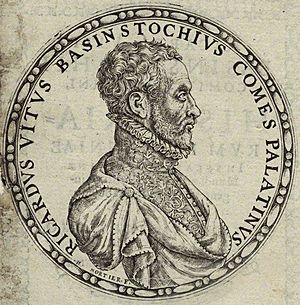Richard White of Basingstoke facts for kids
Richard White (born in 1539, died in 1611) was an important English thinker. He was a jurist, which means he studied and understood laws, and a historian, meaning he wrote about the past. Later in his life, he lived outside England as a scholar and became a Catholic priest.
Contents
Richard White's Early Life and Studies
Richard White was the son of Henry White from Basingstoke, a town in Hampshire, England. His father sadly died in 1544 during a war at Boulogne. Richard's mother was Agnes, whose father was Richard Capelin, also from Hampshire.
Richard was born in Basingstoke. He started attending Winchester School in 1553. This was a famous school. In 1557, he became a permanent fellow at New College, Oxford. A fellow is like a senior student or teacher who gets support from the college. He earned his first university degree, a Bachelor of Arts (B.A.), on May 30, 1559.
Studying Law Abroad
Following advice from John Boxall, Richard White decided to travel overseas to continue his studies, especially in law. Because he left, his fellowship at New College was ended in 1564.
White first went to Louvain in what is now Belgium. Then he moved to the University of Padua in Italy. There, he earned a special degree, becoming a doctor of civil and canon laws. This meant he was an expert in both government laws (civil law) and church laws (canon law).
In 1568, he was accepted into Doctors' Commons in England. This was a group of lawyers who specialized in civil and church law. However, in 1570, he left England again.
Life in Douay
Richard White settled in Douai, a city in France. There, he became a royal professor of law, meaning he taught law at the university. He lived in Douay for twenty years. During this time, he married twice and became quite wealthy from his marriages.
The Pope, who is the head of the Catholic Church, gave him a special role. He was made magnificus rector of the university, which is like being the head or president of the university. Around the same time, he was also given the title of comes palatinus, a special honor from the Holy Roman Emperor.
After his second wife passed away, Richard White received special permission from Pope Clement VIII to become a priest. This is called a dispensation. Around the same time, he was given a canonry in the church of St. Peter in Douay. A canonry means he held a special position as a priest connected to that church. Richard White died in Douay in 1611 and was buried in the church of St. Jacques there.
Richard White's Writings and Books
Richard White was very interested in British history. Important people like Thomas Goldwell, Sir Henry Peacham, Sir Francis Englefield, and especially Cardinal Baronius encouraged him in his studies. He even wrote letters back and forth with Cardinal Baronius.
Here are some of the books and writings Richard White created:
- Ælia Lælia Crispis: This book, published in 1568, was about a mysterious old inscription found in Italy. He tried to explain what it meant.
- Orationes: These were a collection of speeches he gave. Some of them were even ordered to be read publicly at Winchester School. They covered topics like arts, philosophy, and the importance of good speaking.
- R. Viti … Notæ ad leges Decem-virorum: This work, published in 1597, was about ancient Roman laws, including the "Twelve Tables," which were very early Roman laws.
- Historiarum (Britanniæ) libri: This was a multi-part history of Britain, published between 1597 and 1607. It even had his picture at the front! However, some parts of his history relied on writings by Annius of Viterbo, which were later found to be forged (meaning they were fake).
- Oratio septima de religione legum Romanorum: Another speech, this one from 1604, was about the religious side of Roman laws.
- Brevis explicatio privilegiorum iuris et consuetudinis circa venerabile sacramentum Eucharistiæ: This book from 1609 explained the special rules and traditions around the Christian sacrament of the Eucharist.
- De Reliquiis et Veneratione Sanctorum: Also from 1609, this work discussed holy relics and how saints are honored.
- Brevis explicatio Martyrii Sanctæ Ursulæ et undecim millium Virginum Britannarum: His 1610 book told the story of Saint Ursula and the eleven thousand British virgins, who are said to have been martyrs.


